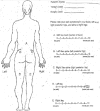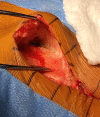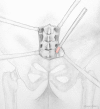Harvest of Iliac Crest Autograft Not Associated With Localized Pain
- PMID: 31328092
- PMCID: PMC6625718
- DOI: 10.14444/6037
Harvest of Iliac Crest Autograft Not Associated With Localized Pain
Abstract
Background: There exists a wide variety of bone grafts, substitutes, and extenders, which are utilized in spinal arthrodesis surgery. While iliac crest autograft is the traditional gold standard for use in spinal arthrodesis, there is considerable discrepancy in the literature regarding its associated complications. Primarily among these is the perception that the procedure is painful and has a high infection rate. The purpose of this study is to determine if patients experience more pain postoperatively on the iliac crest autograft donor side of the pelvis than the contralateral side.
Methods: This study was a retrospective chart analysis of prospectively collected data on 76 patients who underwent elective lumbar arthrodesis with iliac crest autograft performed by one surgeon. The patients filled out a pain diagram with a five-region visual analogue scale, including each iliac crest, at the preoperative and each postoperative visit. Patient-reported pain data at various time points was compared from donor and contralateral sides and analysis included trends over time. Additionally, complications were noted when they occurred. The surgical approach involved a midline skin incision in all patients with epifascial and subperiosteal dissection to the posterior superior iliac spine.
Results: There were no significant differences in reported pain between donor and nondonor side. There was no significant main effect of side of measurement (P = .75) and no significant side by time of measurement interaction effect (P = .95). There was a significant main effect of time of measurement for both sides (P < .001). There were no cases of donor site complications.
Conclusions: Iliac crest harvest and reconstruction utilizing this technique does not result in increased pain on the side of the harvest. This study supports a low morbidity rate for iliac crest autograft harvest as no complications were seen in this series.
Level of evidence: 3.
Keywords: ICBG; arthrodesis; bone; crest; donor; fusion; graft; harvest; iliac; lumbar; morbidity; pain; postoperative; side.
Conflict of interest statement
Disclosures and COI: The authors declare no conflicts of interest. The study protocol was reviewed and approved by the University of Central Florida Institutional Review Board.
Figures









References
LinkOut - more resources
Full Text Sources
Research Materials
